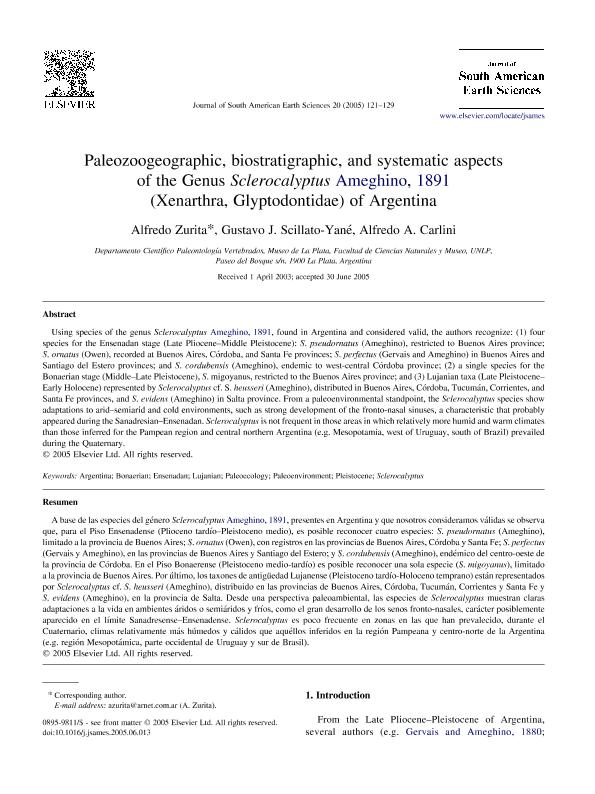Artículo
Paleozoogeographic, biostratigraphic, and systematic aspects of the Genus Sclerocalyptus Ameghino, 1891 (Xenarthra, Glyptodontidae) of Argentina
Fecha de publicación:
10/2005
Editorial:
Pergamon-Elsevier Science Ltd
Revista:
Journal of South American Earth Sciences
ISSN:
0895-9811
Idioma:
Inglés
Tipo de recurso:
Artículo publicado
Clasificación temática:
Resumen
Using species of the genus Sclerocalyptus Ameghino, 1891, found in Argentina and considered valid, the authors recognize: (1) four species for the Ensenadan stage (Late Pliocene-Middle Pleistocene): S. pseudornatus (Ameghino), restricted to Buenos Aires province; S. ornatus (Owen), recorded at Buenos Aires, Córdoba, and Santa Fe provinces; S. perfectus (Gervais and Ameghino) in Buenos Aires and Santiago del Estero provinces; and S. cordubensis (Ameghino), endemic to west-central Córdoba province; (2) a single species for the Bonaerian stage (Middle-Late Pleistocene), S. migoyanus, restricted to the Buenos Aires province; and (3) Lujanian taxa (Late Pleistocene-Early Holocene) represented by Sclerocalyptus cf. S. heusseri (Ameghino), distributed in Buenos Aires, Córdoba, Tucumán, Corrientes, and Santa Fe provinces, and S. evidens (Ameghino) in Salta province. From a paleoenvironmental standpoint, the Sclerocalyptus species show adaptations to arid-semiarid and cold environments, such as strong development of the fronto-nasal sinuses, a characteristic that probably appeared during the Sanadresian-Ensenadan. Sclerocalyptus is not frequent in those areas in which relatively more humid and warm climates than those inferred for the Pampean region and central northern Argentina (e.g. Mesopotamia, west of Uruguay, south of Brazil) prevailed during the Quaternary. © 2005 Elsevier Ltd. All rights reserved.
Archivos asociados
Licencia
Identificadores
Colecciones
Articulos(CECOAL)
Articulos de CENTRO DE ECOLOGIA APLICADA DEL LITORAL (I)
Articulos de CENTRO DE ECOLOGIA APLICADA DEL LITORAL (I)
Citación
Zurita, Alfredo Eduardo; Scillato, Gustavo Juan; Carlini, Alfredo Armando; Paleozoogeographic, biostratigraphic, and systematic aspects of the Genus Sclerocalyptus Ameghino, 1891 (Xenarthra, Glyptodontidae) of Argentina; Pergamon-Elsevier Science Ltd; Journal of South American Earth Sciences; 20; 1-2; 10-2005; 121-129
Compartir
Altmétricas




